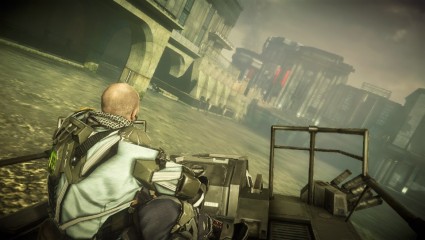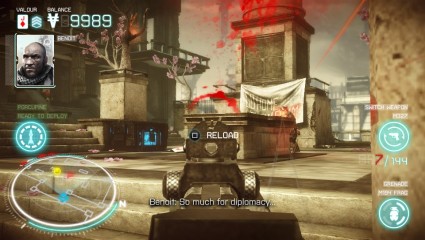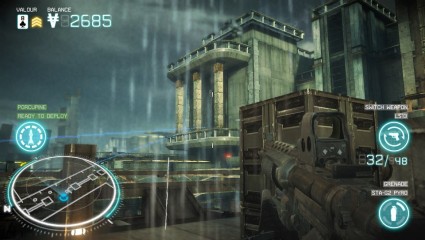Reviews
Killzone: Mercenary
September 25, 2013, Author: Andy Corrigan
As a site, we’ve discussed the misfortune of the first-person shooter on the Vita a couple of times before. After Nihilistic’s prior, piss-poor efforts with Resistance: Burning Skies and Call of Duty: Black Ops Declassified, I think that it was inevitable that we would fear the worst for Sony’s flagship shooter franchise when it eventually arrived on handheld, in spite of promising previews and a solid public Beta release.
Well, Killzone: Mercenary is finally here, and you needn’t have worried. It’s every bit the handheld shooter you’ve been craving.
Soldiers of fortune
The year is 2357 and you are Arran Danner, a mercenary with the Phantom Talon Corp caught bang in the middle of Helghan’s war on Vekta. The ISA are seriously struggling to cope with the demands of war and seem happy to pay for extra support and, of course, the cash-hungry Danner and his colleague Benoit are all too eager to take their money. Being mercenaries, though, their services will always go to the highest bidder and that means at some point you’ll be working for the Helghast… but not in the way you’ll have been expecting from the drips of information coming from developer Guerrilla Cambridge.
This works to the game’s benefit, because the idea of a Human UNC soldier switching sides against his own faction didn’t make much sense in my noggin, even with the cash on the table, but with the context presented here it totally fits and kinda makes the plot feel like one of the more interesting in the series. Does it reach its full storytelling potential? No, certainly not, but it at least toys with the idea that the ISA aren’t exactly the shining knights of justice they perceive themselves to be in the other games, and that’s a very interesting angle.

There’s an astonishing amount of detail on display.
The killing field
The first and most important thing to say about actually playing Killzone: Mercenary is that it really does feel just like Killzone. Movement and control is super smooth and natural, and the series’ trademark weighting to the player character provides a believable feeling of momentum, especially when running or sliding into cover.
Just like the core Killzone games, enemies attack in large numbers and they press you bloody hard, pressuring you at every opportunity. There’s always a sense of 360° danger as enemies do their best to flank and flush you out of cover when you’re dug in, and they’re also intelligent enough to seek cover themselves when under fire, blind-firing in retaliation appropriately when you’re closing on them. Enemies never feel weak or dumb in Mercenary because of this.
Excellent level design also helps to keep the fights varied and exciting, with a great mix of tight, funneled stretches and open arenas offering you the chance to experiment with your approach. Everything you want from a home console campaign has been squashed down to fit on here: explosive set-pieces? Check! Large-scale shootouts? Check! On-rails air battles? Sniper Alley? Check and Check!
As the name Mercenary might suggest, money is earned through kills and completing mission objectives. Your hard-fought cash can then be spent on refreshing your loadout at the weapon caches scattered throughout the levels. Struggling in the middle of a fire fight because the Helghast are bringing the heavies in? Simply fight your way to a station and buy a better gun. Firing your new, shiny weaponry is a fantastically satisfying experience too, with a lovely, chunky and powerful feeling when the trigger is pulled. Each also feels different somehow, despite this console offering no physical feedback other than button presses. Great work by the development team in that regard.
One of the coolest additions you can make to your arsenal is a VAN-Guard System; useful abilities that can turn the tide of combat. From remote control drones that can silently stab foes upside their head; radars that point out enemy locations; shields; signal jammers; to the far less subtle power of the Porcupine (which fires homing missiles at whatever target you touch on-screen); each is highly useful, incredibly cool and can benefit your chosen approach to missions.
Of course, as a Vita game, Mercenary makes sure to offer you some touchscreen functionality, but it actually forces you to use very little of it. For example, actions such as button presses or melee kills can be initiated by pressing the on-screen prompt, but if you prefer, you can just use the triangle button. Grenades can be thrown by hitting the handily placed on-screen button, or you can tap down on the D-pad. Sprinting too can be achieved by tapping and holding on the rear touchpad, or by tapping the crouch button once; the choice is yours and it caters for all.
The times in which touchscreen controls are forced upon you (which are fleeting), they’re actually used to decent effect. The brutal melee kills, as an example, can be initiated with the triangle button, but the following attack requires a screen swipe. This is made easier by the fact that you don’t need to shift your hand to achieve this; you can just perform a small swipe at the edge of the screen. They at least have context too, as the direction swiped bats the enemy’s gun or hand away before you make the fatal blow. Likewise, certain levers and switches will also require these touches, but thanks to the implementation it’s not a chore as in certain other games.
One element that does let the side down somewhat, though, is the hacking mini-game. Presenting you with a selection of icons, you need to quickly work out which two partial icons make up a complete one. This is neither taxing nor mentally stimulating, and it does nothing but pull you out of the game’s awesome combat. If you’re chasing the cash and trying to hack all optional terminals in a bid to buy more guns, the reliance on this mechanic will feel a little too frequent.

You can approach the game in a number of different ways.
Although valid complaints could be made towards the game’s length (and it could have stood to have been a tad longer, I’ll give you that), the surprising size and scope of the missions it features just about makes up for it. Going in I honestly expected most of the missions to be tiny, bite-sized offerings, but instead you’re provided with lengthy missions with excellent transitioning and pacing.
The Contracts mode should also stand to console those that deem the main campaign too short, offering plenty of replayability for those that want it. Essentially replaying the game’s levels in any order you want, you’re able to select a contract play-style, and with it you get a whole load of additional objectives to complete in-game. So for example, a Precision contract for the opening level will require you to complete objectives such as beating the level within twenty minutes, bagging twenty headshots with a particular SMG, and rescuing all the hostages. Other contract styles include Covert and Demolitions, meaning that you’ll end up playing the game in a number of different ways. It’s an interesting way to revisit moments from the core game.
While much of the content here can’t exactly be called original, who cares when it’s this much fun and you can carry it in your pocket?
Bloodbath
The accompanying screenshots really don’t lie: Mercenary is a gorgeous title throughout and it looks even better in motion. In spite of the occasional flat texture or oddly designed piece of scenery that you’re meant to glance over (hexagonal wheels on a sack truck, for example), at times it looks akin to early PS3 titles. It’s seriously impressive considering that you’re looking at a handheld.
Not only do the immediate areas look rich and full of detail; even distant buildings and views add a grand sense of depth and scale. These worlds look believable, lived in and, more importantly, fought in. NPCs and enemies too look brilliant as they run and move believably from cover to cover with smooth animations. The game’s warring factions actually look like they’re a part of this game world, and not just sprites and polygons occupying it.
It does all this and performs well too. I’ve not seen a single glitch or frame drop. Put simply, not much has been compromised visually in squashing the Killzone experience down to the handheld.
Helghastly noise
Killzone: Mercenary is easily one of the most audibly powerful games I’ve played on Vita. The audio is crystal clear, the guns in particular sound phenomenally punchy, and explosions are dirty. I’ve spent most of my playtime using my Turtle Beach M1 ear buds and it sounds exceptional played in this way. Unlike the system’s far shittier FPS output, Resistance: Burning Skies and Call of Duty: Black Ops Declassified, which both had a real problem in sound engineering, you can actually tell what’s going on around you in Mercenary just by listening. It’s amazing how much difference good sound makes.
The voice acting is unexpectedly very solid too, especially in regards to the campaign. I love the English accents of the Helghast, always have; but the delivery all round, particularly from both the key antagonists, is excellent. It was also great to hear what I believe to be Brian Cox as Scolar Visari again, with one of his rousing propaganda speeches playing over loudspeakers in certain missions on Helghan.

The world feels lived and fought in.
The history of these days shall be written in blood
I’ll just state this right off the bat: this is the most fully-realised portable multiplayer mode I’ve ever played. Up to eight players can jump right in and battle against each other in not only Solo or Team Deathmatches, but also the series’ staple mode, Warzone, which is still easily the most fun of the bunch.
Warzone, of course, sees both sides given five random objectives over the course of its playtime. So for one round you might be playing only to kill members of the other team, another you’ll be playing to capture or destroy strategic locations. The switcheroo between game types happens in the middle of combat, meaning that players need to think fast and be adaptable. Just as with the home console games, it at times feels like you’re playing an organic single-player campaign.
The included maps are a great selection, perfectly suited to the game types on offer. Each is large enough that Warzone always feels like a natural fit no matter which you’re on, but they’re not that big that Team Deathmatch ever feels empty or void of action. Each is expertly designed, full of exhilarating choke points, hidey-holes, sniper vantage points and enough cover to keep general battles fair and exciting regardless of how you choose to play.
The netcode is surprisingly solid too. Not once have I been kicked out of game as I was repeatedly in Burning Skies or Black Ops Declassified, nor have I experienced lag in any form in play-testing. It runs so smoothly, in fact, that it’s the most fun I’ve had in a multiplayer mode in well over a year and I can see myself returning to it often.
ISA this the portable shooter you’ve been waiting for?
You could nit-pick, sure, but the answer to the above question is unequivocally yes. No other first-person shooter on this or comparable platforms has even come close to the overall level of quality on display here, offline or on. Mercenary plays so well, looks and sounds so great that even though it might not be quite as grandiose as many shooters on home consoles or PC, at times it’s almost inconceivable that you’re playing this on a handheld console in the first place.
That’s a pretty incredible achievement worth celebrating, if you ask me.
Platforms: PS Vita | Tagged Call of Duty: Black Ops Declassified, first person shooter, Killzone, killzone 3, Resistance: Burning Skies, Vita



